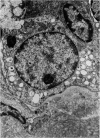Abstract
The enterochromaffin-like (ECL) cells represent the predominant endocrine cell population in the acid-producing part of the stomach of both experimental animals and man. These cells actively produce and store histamine in addition to an anticipated but as yet unidentified peptide hormone and are under the control of gastrin. An acute gastrin stimulus causes exocytosis of the cytoplasmic granules/vesicles (and release of histamine and activation of the histamine-forming enzyme, histidine decarboxylase), while a more sustained gastrin stimulus causes first hypertrophy and then hyperplasia of the ECL cells in the rat (at most, a fivefold increase in the cell number). These effects can be demonstrated following infusion of gastrin or following an increase in the concentration of circulating gastrin of endogenous origin. The growth of the ECL cells reflects an accelerated self-replication rate. As studied in the rat, the self-replication rate is accelerated quite soon after induction of hypergastrinemia (blockade of acid secretion), the rate is maximally elevated within two weeks and then declines to control values at ten and 20 weeks despite the sustained hypergastrinemia. Lifelong hypergastrinemia in rats is associated not only with ECL-cell hyperplasia but also with an increased incidence of ECL-cell carcinoids. Recently, we could show that alpha-fluoromethylhistidine, which is a suicide inhibitor of histidine decarboxylase, effectively depletes the ECL cells of histamine and that the histamine-depleted ECL cells respond to gastrin with hyperplasia in a manner identical to normal ECL cells. Other factors beside gastrin seem to participate in the control of ECL-cell function and proliferation. Although exogenous somatostatin is known to suppress the activity of the ECL cells, we have failed to obtain evidence that the somatostatin cells in the oxyntic mucosa play a role in the physiological control of the ECL cells. The vagus, however, is important for the ability of the ECL cells to respond to gastrin. This conclusion is based on the observation that vagal denervation suppresses the hyperplastic response of the ECL cells to gastrin. Porta-cava shunting, on the other hand, greatly enhances the responsiveness of the ECL cells to gastrin. The mechanism behind this effect is unknown.
Full text
PDF
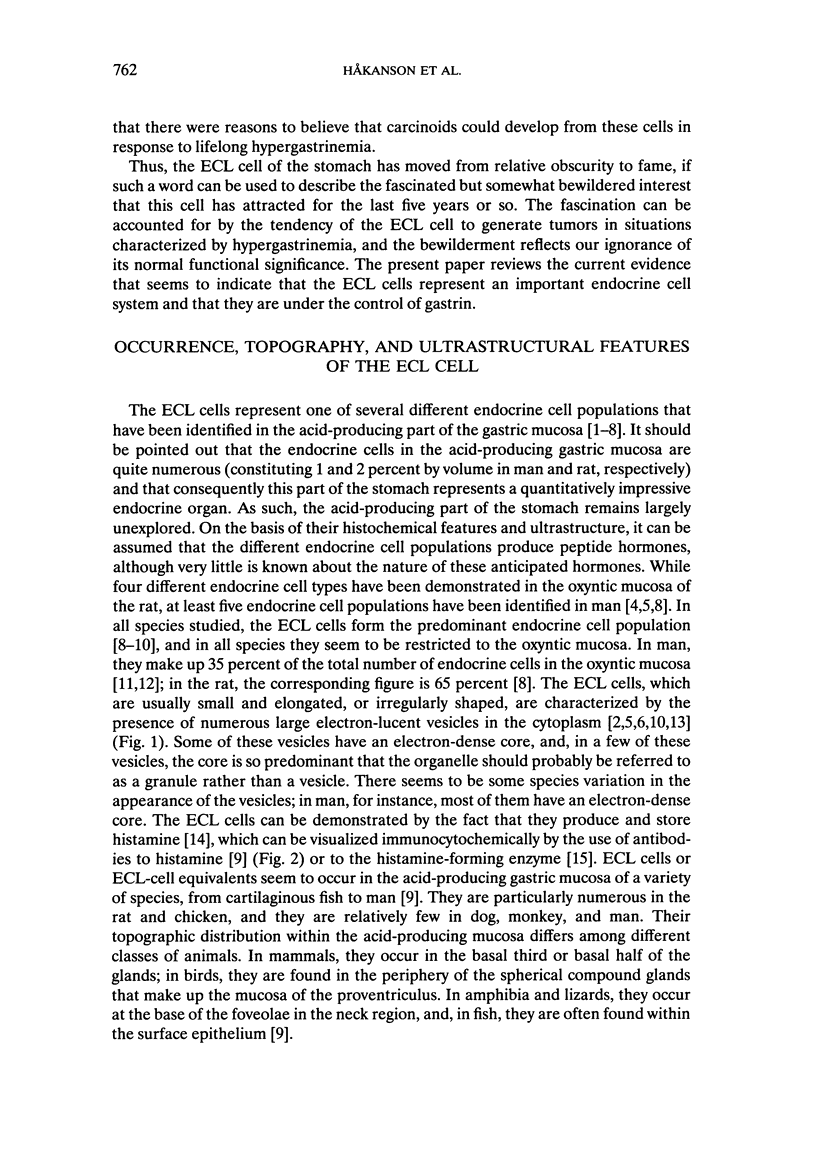
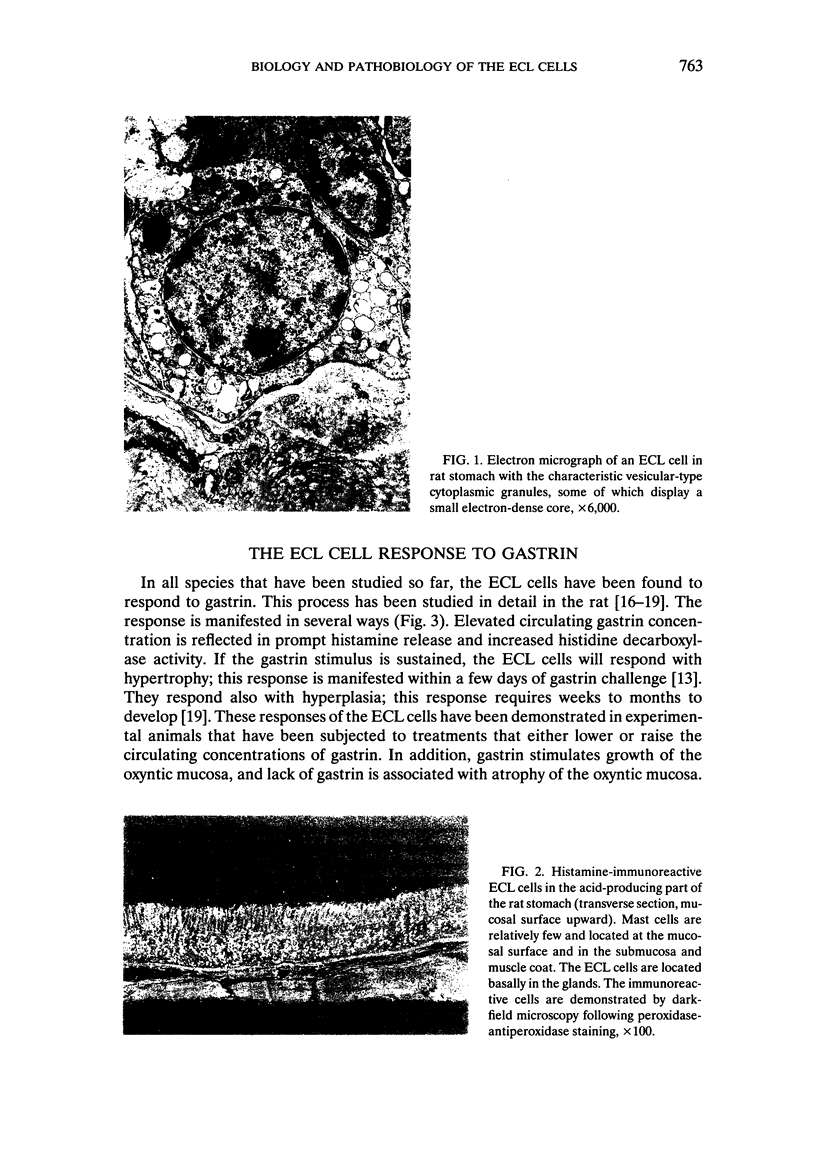
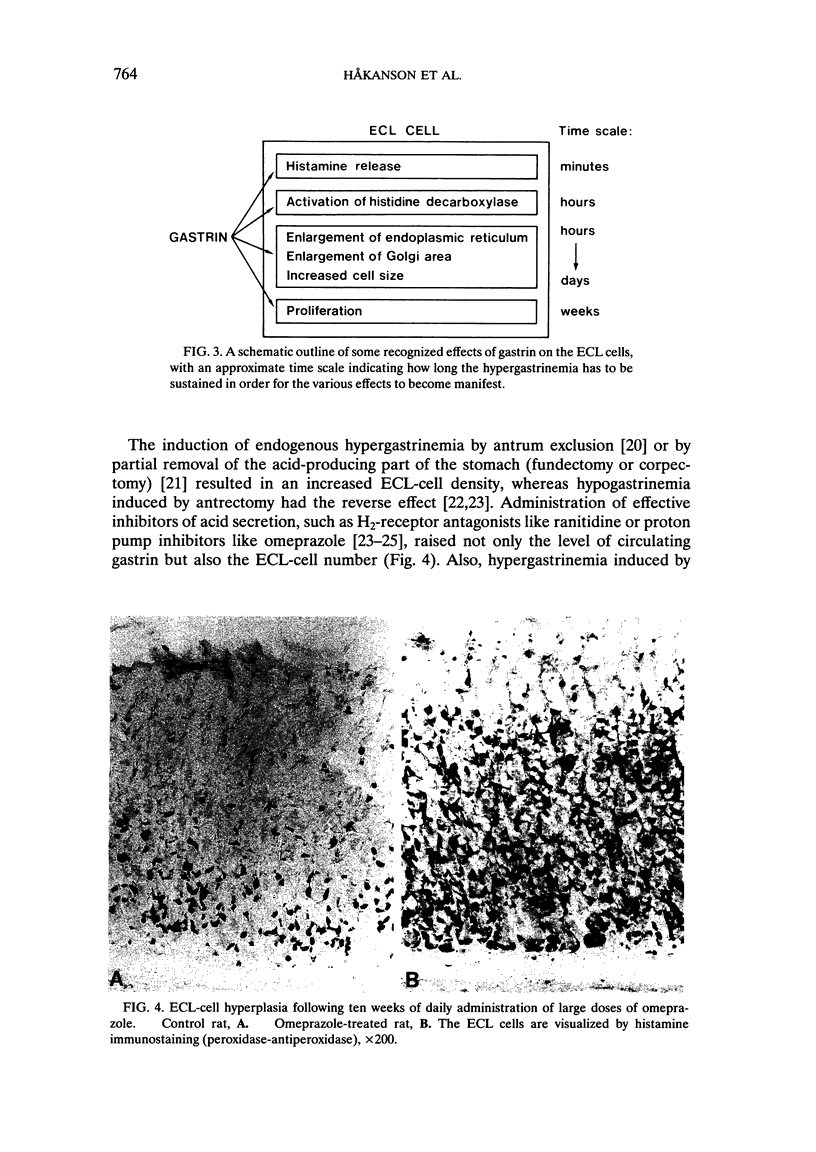
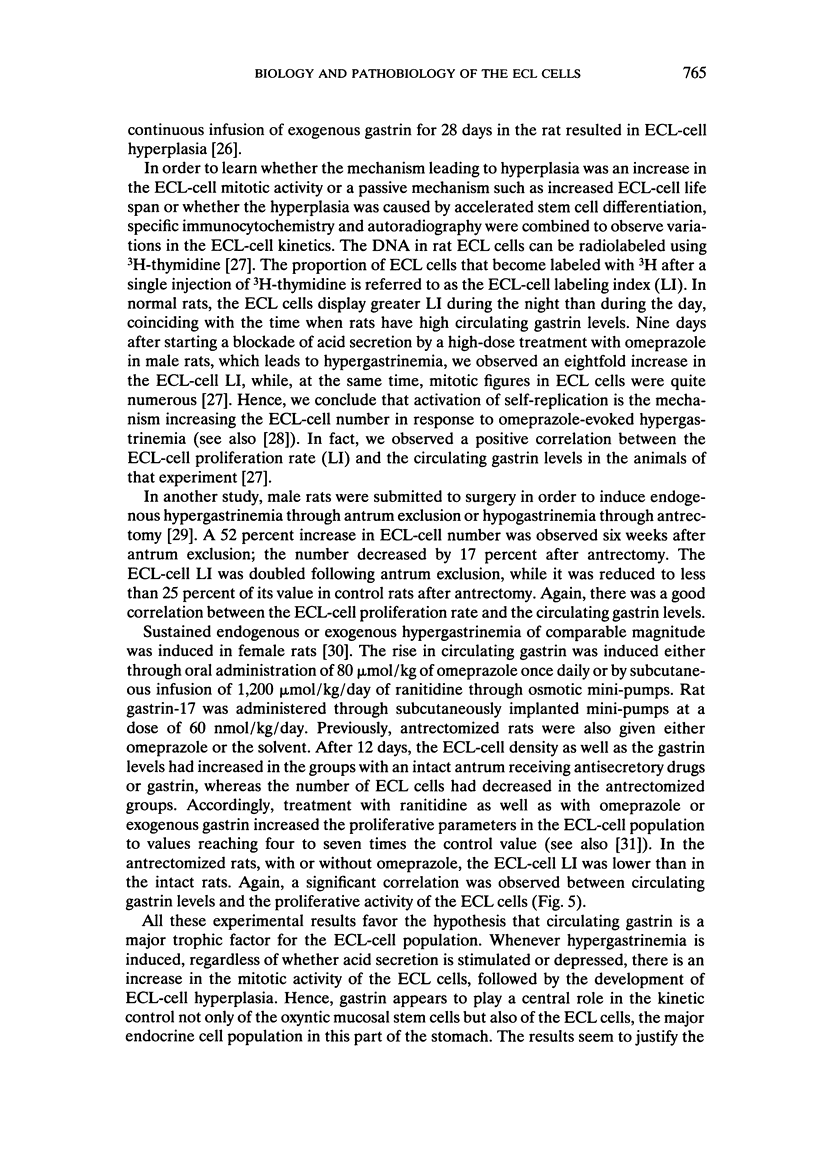
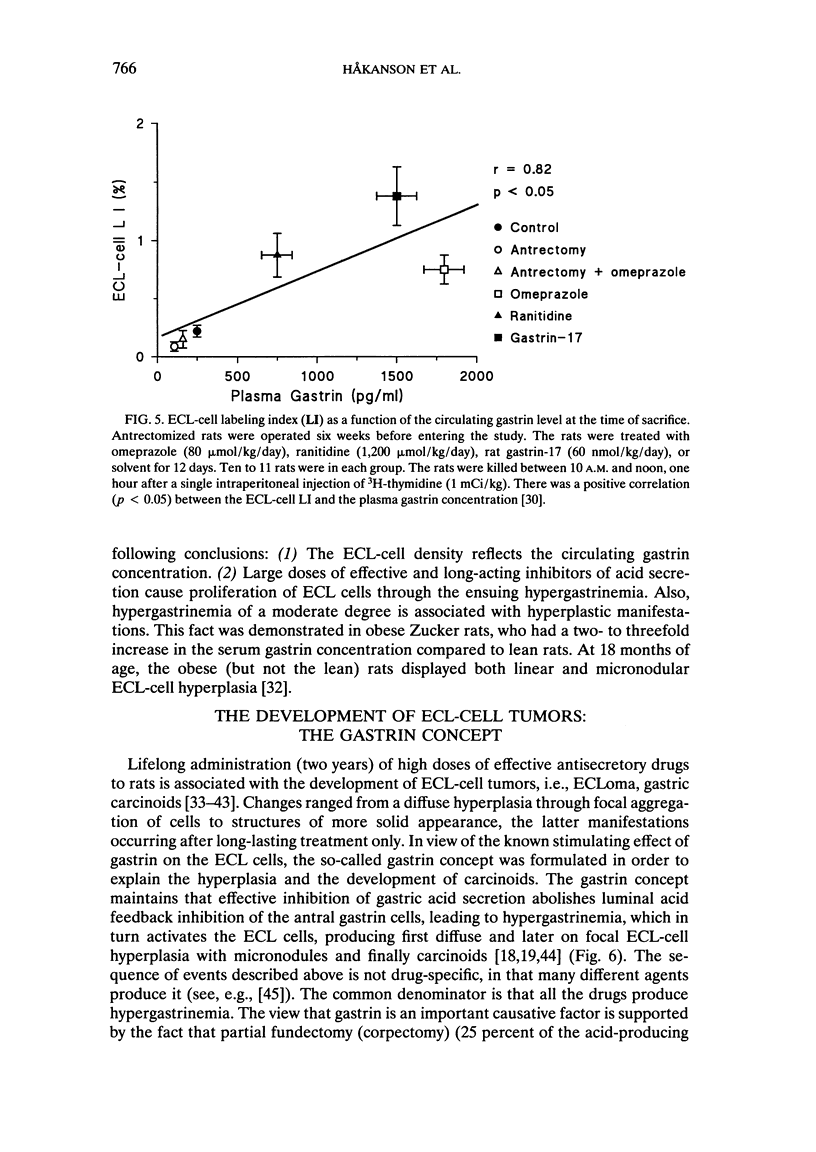
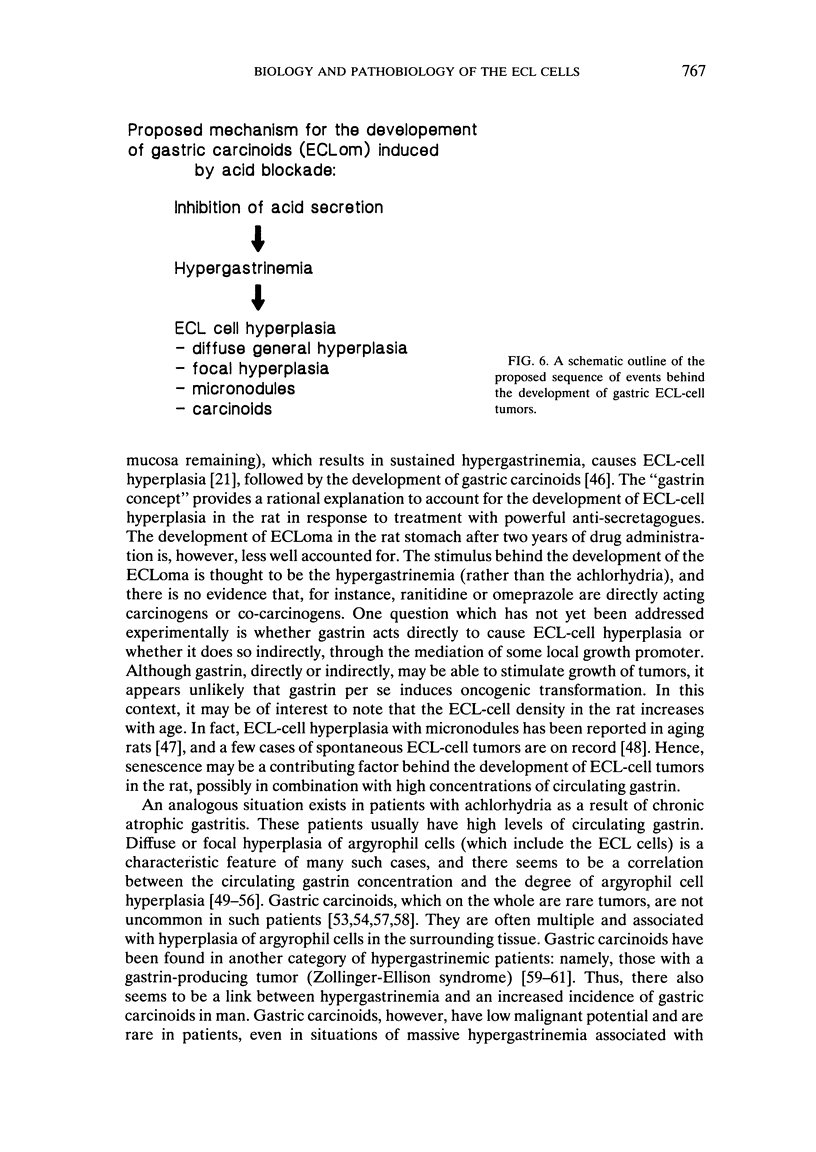
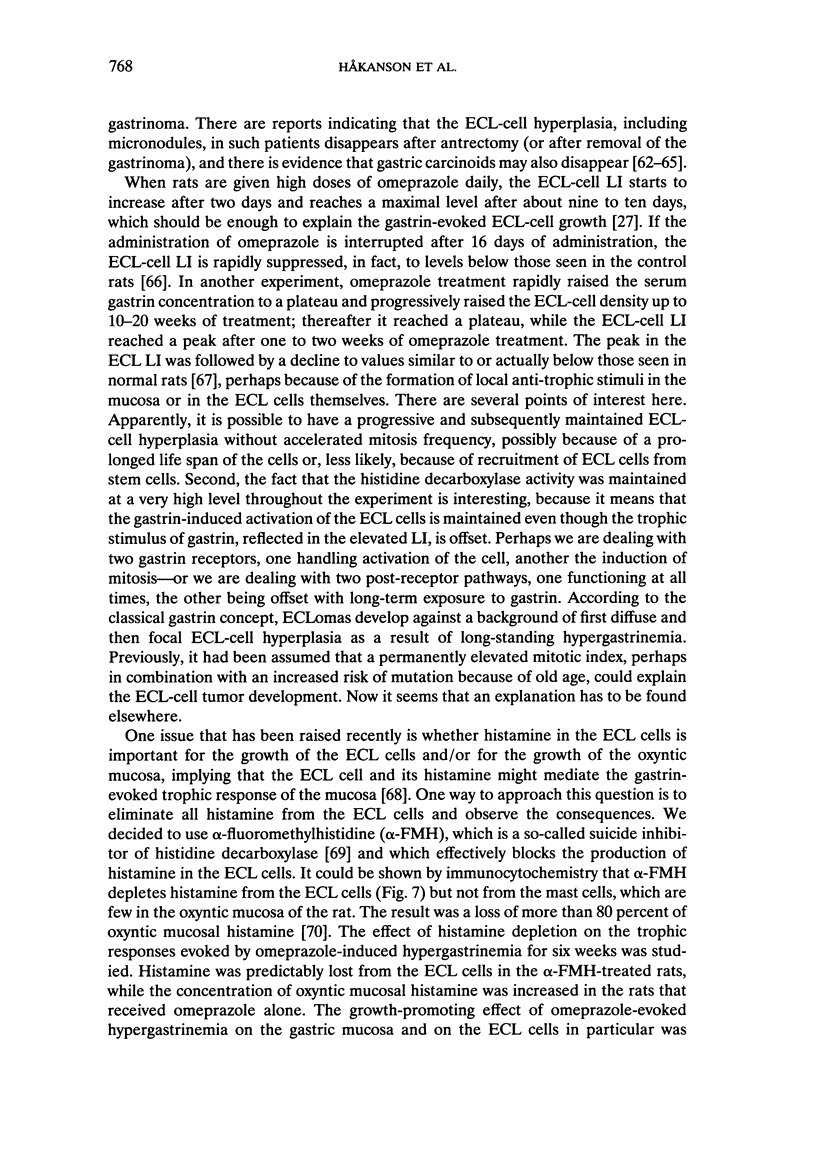
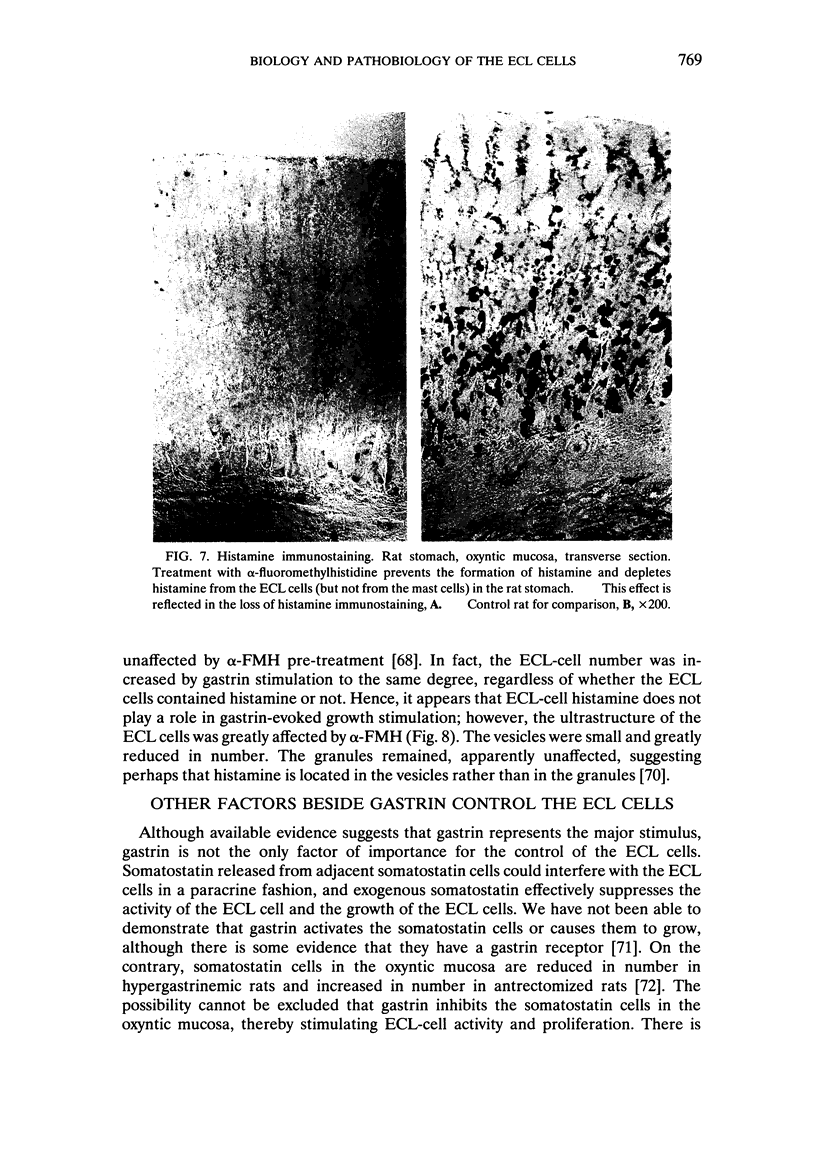
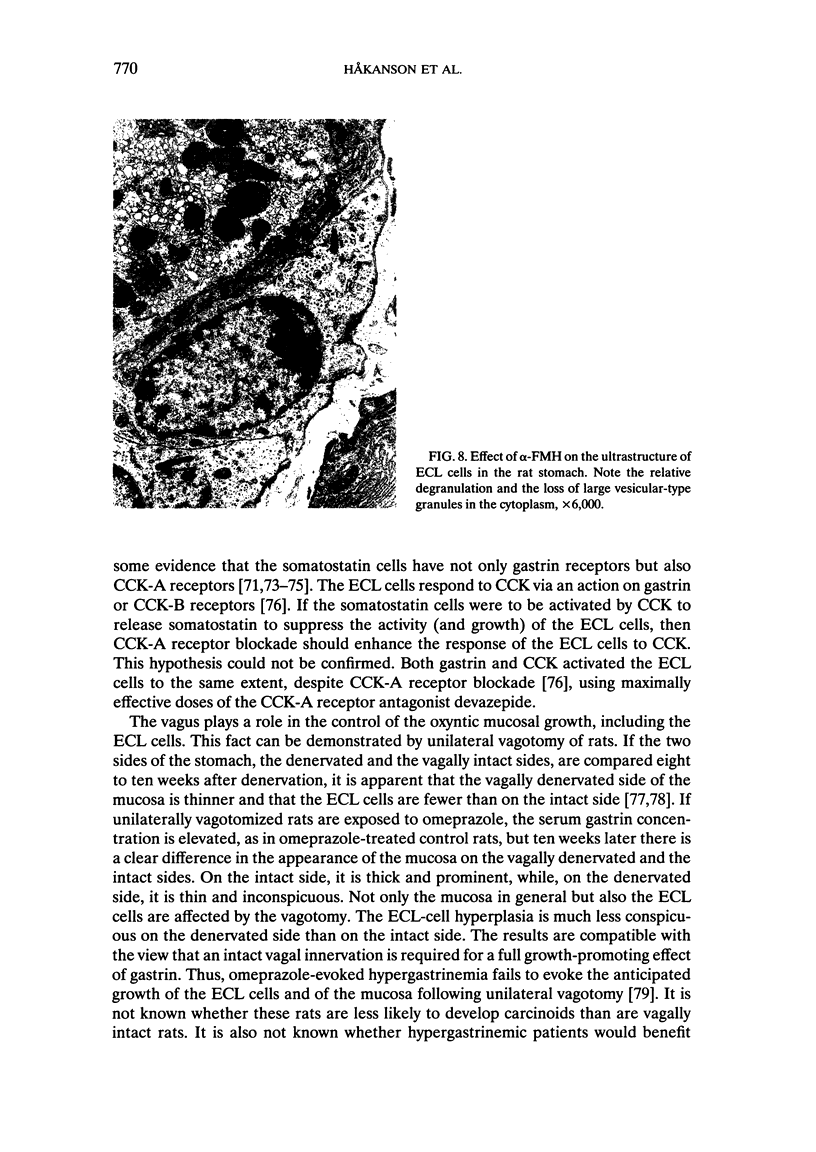
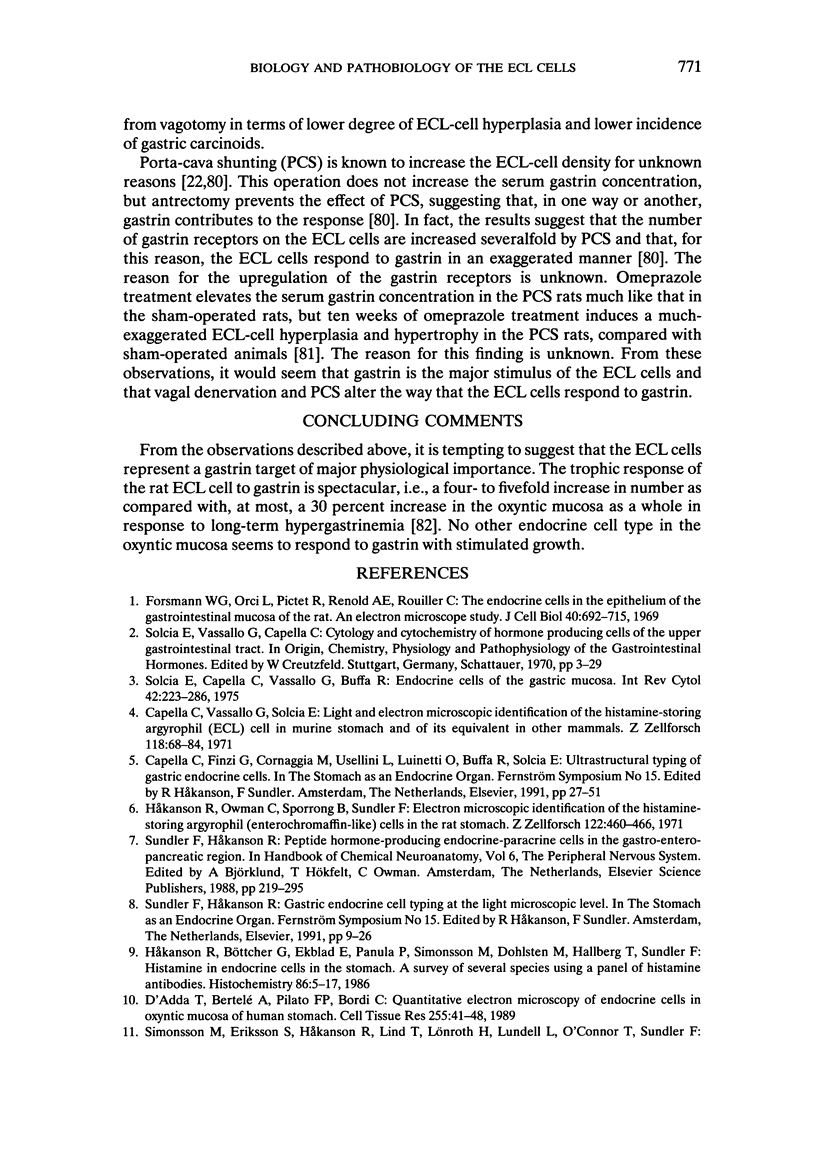
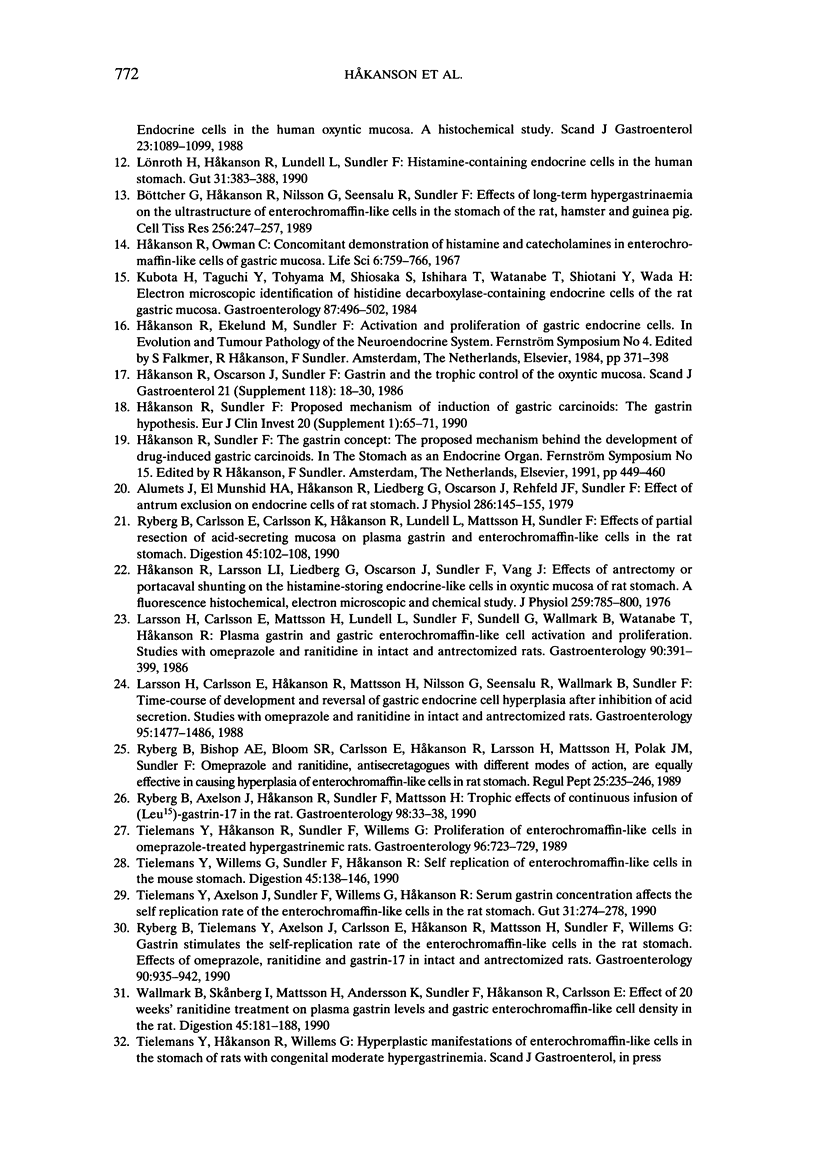
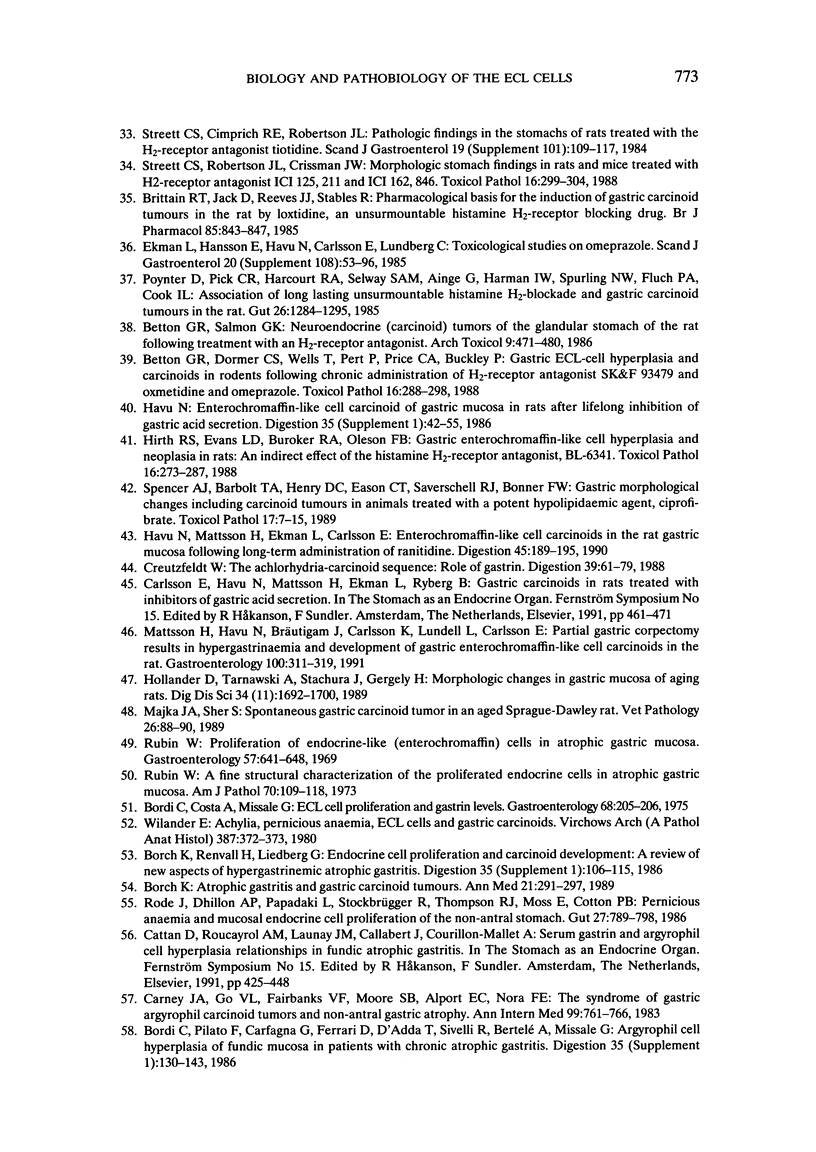
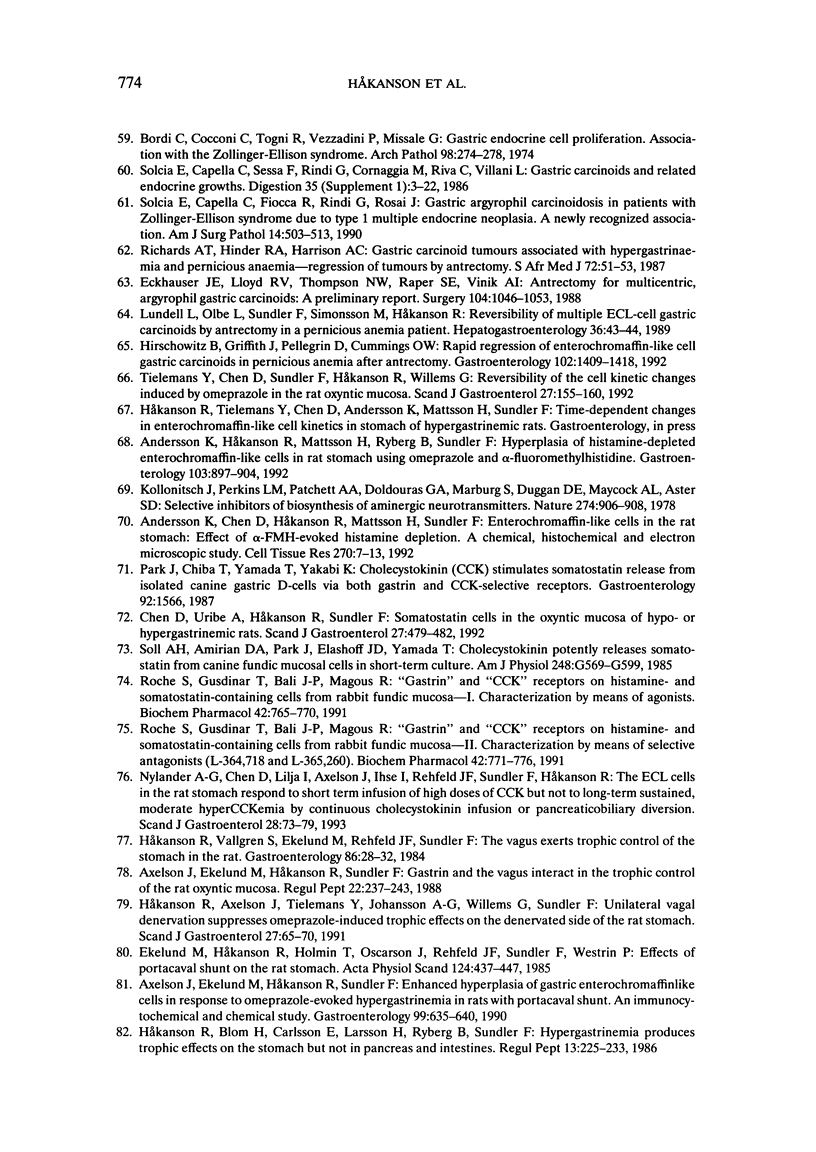
Images in this article
Selected References
These references are in PubMed. This may not be the complete list of references from this article.
- Alumets J., El Munshid H. A., Håkanson R., Liedberg G., Oscarson J., Rehfeld J. F., Sundler F. Effect of antrum exclusion on endocrine cells of rat stomach. J Physiol. 1979 Jan;286:145–155. doi: 10.1113/jphysiol.1979.sp012610. [DOI] [PMC free article] [PubMed] [Google Scholar]
- Andersson K., Chen D., Håkanson R., Mattsson H., Sundler F. Enterochromaffin-like cells in the rat stomach: effect of alpha-fluoromethylhistidine-evoked histamine depletion. A chemical, histochemical and electron-microscopic study. Cell Tissue Res. 1992 Oct;270(1):7–13. doi: 10.1007/BF00381874. [DOI] [PubMed] [Google Scholar]
- Andersson K., Håkanson R., Mattsson H., Ryberg B., Sundler F. Hyperplasia of histamine-depleted enterochromaffinlike cells in rat stomach using omeprazole and alpha-fluoromethylhistidine. Gastroenterology. 1992 Sep;103(3):897–904. doi: 10.1016/0016-5085(92)90023-r. [DOI] [PubMed] [Google Scholar]
- Axelson J., Ekelund M., Håkanson R., Sundler F. Gastrin and the vagus interact in the trophic control of the rat oxyntic mucosa. Regul Pept. 1988 Aug;22(3):237–243. doi: 10.1016/0167-0115(88)90036-5. [DOI] [PubMed] [Google Scholar]
- Axelson J., Ekelund M., Sundler F., Håkanson R. Enhanced hyperplasia of gastric enterochromaffinlike cells in response to omeprazole-evoked hypergastrinemia in rats with portacaval shunts. An immunocytochemical and chemical study. Gastroenterology. 1990 Sep;99(3):635–640. doi: 10.1016/0016-5085(90)90948-z. [DOI] [PubMed] [Google Scholar]
- Betton G. R., Dormer C. S., Wells T., Pert P., Price C. A., Buckley P. Gastric ECL-cell hyperplasia and carcinoids in rodents following chronic administration of H2-antagonists SK&F 93479 and oxmetidine and omeprazole. Toxicol Pathol. 1988;16(2):288–298. doi: 10.1177/019262338801600222. [DOI] [PubMed] [Google Scholar]
- Borch K. Atrophic gastritis and gastric carcinoid tumours. Ann Med. 1989 Aug;21(4):291–297. doi: 10.3109/07853898909149210. [DOI] [PubMed] [Google Scholar]
- Borch K., Renvall H., Liedberg G. Endocrine cell proliferation and carcinoid development: a review of new aspects of hypergastrinaemic atrophic gastritis. Digestion. 1986;35 (Suppl 1):106–115. doi: 10.1159/000199386. [DOI] [PubMed] [Google Scholar]
- Bordi C., Cocconi G., Togni R., Vezzadini P., Missale G. Gastric endocrine cell proliferation. Association with Zollinger-Ellison syndrome. Arch Pathol. 1974 Oct;98(4):274–278. [PubMed] [Google Scholar]
- Bordi C., Costa A., Missale G. Letter: ECL cell proliferation and gastrin levels. Gastroenterology. 1975 Jan;68(1):205–206. [PubMed] [Google Scholar]
- Bordi C., Pilato F., Carfagna G., Ferrari C., D'Adda T., Sivelli R., Bertelé A., Missale G. Argyrophil cell hyperplasia of fundic mucosa in patients with chronic atrophic gastritis. Digestion. 1986;35 (Suppl 1):130–143. doi: 10.1159/000199389. [DOI] [PubMed] [Google Scholar]
- Brittain R. T., Jack D., Reeves J. J., Stables R. Pharmacological basis for the induction of gastric carcinoid tumours in the rat by loxtidine, an insurmountable histamine H2-receptor blocking drug. Br J Pharmacol. 1985 Aug;85(4):843–847. doi: 10.1111/j.1476-5381.1985.tb11083.x. [DOI] [PMC free article] [PubMed] [Google Scholar]
- Böttcher G., Håkanson R., Nilsson G., Seensalu R., Sundler F. Effects of long-term hypergastrinaemia on the ultrastructure of enterochromaffin-like cells in the stomach of the rat, hamster and guinea pig. Cell Tissue Res. 1989;256(2):247–257. doi: 10.1007/BF00218882. [DOI] [PubMed] [Google Scholar]
- Capella C., Vassallo G., Solcia E. Light and electron microscopic identification of the histamine-storing argyrophil (ECL) cell in murine stomach and of its equivalent in other mammals. Z Zellforsch Mikrosk Anat. 1971;118(1):68–84. doi: 10.1007/BF00331767. [DOI] [PubMed] [Google Scholar]
- Carney J. A., Go V. L., Fairbanks V. F., Moore S. B., Alport E. C., Nora F. E. The syndrome of gastric argyrophil carcinoid tumors and nonantral gastric atrophy. Ann Intern Med. 1983 Dec;99(6):761–766. doi: 10.7326/0003-4819-99-6-761. [DOI] [PubMed] [Google Scholar]
- Chen D., Uribe A., Håkanson R., Sundler F. Somatostatin cells in the oxyntic mucosa of hypo- or hypergastrinemic rats. Scand J Gastroenterol. 1992 Jun;27(6):479–482. doi: 10.3109/00365529209000108. [DOI] [PubMed] [Google Scholar]
- Creutzfeldt W. The achlorhydria-carcinoid sequence: role of gastrin. Digestion. 1988;39(2):61–79. doi: 10.1159/000199609. [DOI] [PubMed] [Google Scholar]
- D'Adda T., Bertelé A., Pilato F. P., Bordi C. Quantitative electron microscopy of endocrine cells in oxyntic mucosa of normal human stomach. Cell Tissue Res. 1989 Jan;255(1):41–48. doi: 10.1007/BF00229064. [DOI] [PubMed] [Google Scholar]
- Eckhauser F. E., Lloyd R. V., Thompson N. W., Raper S. E., Vinik A. I. Antrectomy for multicentric, argyrophil gastric carcinoids: a preliminary report. Surgery. 1988 Dec;104(6):1046–1053. [PubMed] [Google Scholar]
- Ekelund M., Håkanson R., Holmin T., Oscarson J., Rehfeld J. F., Sundler F., Westrin P. Effects of portacaval shunt on the rat stomach. Acta Physiol Scand. 1985 Jul;124(3):437–447. doi: 10.1111/j.1748-1716.1985.tb07680.x. [DOI] [PubMed] [Google Scholar]
- Ekman L., Hansson E., Havu N., Carlsson E., Lundberg C. Toxicological studies on omeprazole. Scand J Gastroenterol Suppl. 1985;108:53–69. [PubMed] [Google Scholar]
- Forssmann W. G., Orci L., Pictet R., Renold A. E., Rouiller C. The endocrine cells in the epithelium of the gastrointestinal mucosa of the rat. An electron microscope study. J Cell Biol. 1969 Mar;40(3):692–715. doi: 10.1083/jcb.40.3.692. [DOI] [PMC free article] [PubMed] [Google Scholar]
- Havu N. Enterochromaffin-like cell carcinoids of gastric mucosa in rats after life-long inhibition of gastric secretion. Digestion. 1986;35 (Suppl 1):42–55. doi: 10.1159/000199381. [DOI] [PubMed] [Google Scholar]
- Havu N., Mattsson H., Ekman L., Carlsson E. Enterochromaffin-like cell carcinoids in the rat gastric mucosa following long-term administration of ranitidine. Digestion. 1990;45(4):189–195. doi: 10.1159/000200245. [DOI] [PubMed] [Google Scholar]
- Hirschowitz B. I., Griffith J., Pellegrin D., Cummings O. W. Rapid regression of enterochromaffinlike cell gastric carcinoids in pernicious anemia after antrectomy. Gastroenterology. 1992 Apr;102(4 Pt 1):1409–1418. [PubMed] [Google Scholar]
- Hirth R. S., Evans L. D., Buroker R. A., Oleson F. B. Gastric enterochromaffin-like cell hyperplasia and neoplasia in the rat: an indirect effect of the histamine H2-receptor antagonist, BL-6341. Toxicol Pathol. 1988;16(2):273–287. doi: 10.1177/019262338801600221. [DOI] [PubMed] [Google Scholar]
- Hollander D., Tarnawski A., Stachura J., Gergely H. Morphologic changes in gastric mucosa of aging rats. Dig Dis Sci. 1989 Nov;34(11):1692–1700. doi: 10.1007/BF01540046. [DOI] [PubMed] [Google Scholar]
- Häkanson R., Larsson L. I., Liedberg G., Oscarson J., Sundler F., Vang J. Effects of antrectomy or porta-caval shunting on the histamine-storing endocrine-like cells in oxyntic mucosa of rat stomach. A fluorescence histochemical, electron microscopic and chemical study. J Physiol. 1976 Aug;259(3):785–800. doi: 10.1113/jphysiol.1976.sp011495. [DOI] [PMC free article] [PubMed] [Google Scholar]
- Håkanson R., Axelson J., Tielemans Y., Johansson A. G., Willems G., Sundler F. Unilateral vagal denervation suppresses omeprazole-induced trophic effects on the denervated side of the rat stomach. Scand J Gastroenterol. 1992;27(1):65–70. doi: 10.3109/00365529209011169. [DOI] [PubMed] [Google Scholar]
- Håkanson R., Blom H., Carlsson E., Larsson H., Ryberg B., Sundler F. Hypergastrinaemia produces trophic effects in stomach but not in pancreas and intestines. Regul Pept. 1986 Feb;13(3-4):225–233. doi: 10.1016/0167-0115(86)90041-8. [DOI] [PubMed] [Google Scholar]
- Håkanson R., Böttcher G., Ekblad E., Panula P., Simonsson M., Dohlsten M., Hallberg T., Sundler F. Histamine in endocrine cells in the stomach. A survey of several species using a panel of histamine antibodies. Histochemistry. 1986;86(1):5–17. doi: 10.1007/BF00492340. [DOI] [PubMed] [Google Scholar]
- Håkanson R., Oscarson J., Sundler F. Gastrin and the trophic control of gastric mucosa. Scand J Gastroenterol Suppl. 1986;118:18–30. doi: 10.3109/00365528609090883. [DOI] [PubMed] [Google Scholar]
- Håkanson R., Owman C. Concomitant histochemical demonstration of histamine and catecholamines in enterochromaffin-like cells of gastric mucosa. Life Sci. 1967 Apr 1;6(7):759–766. doi: 10.1016/0024-3205(67)90133-6. [DOI] [PubMed] [Google Scholar]
- Håkanson R., Owman C., Sporrong B., Sundler F. Electron microscopic identification of the histamine-storing argyrophil (enterochromaffin-like) cells in the rat stomach. Z Zellforsch Mikrosk Anat. 1971;122(4):460–466. doi: 10.1007/BF00936080. [DOI] [PubMed] [Google Scholar]
- Håkanson R., Vallgren S., Ekelund M., Rehfeld J. F., Sundler F. The vagus exerts trophic control of the stomach in the rat. Gastroenterology. 1984 Jan;86(1):28–32. [PubMed] [Google Scholar]
- Kollonitsch J., Perkins L. M., Patchett A. A., Doldouras G. A., Marburg S., Duggan D. E., Maycock A. L., Aster S. D. Selective inhibitors of biosynthesis of aminergic neurotransmitters. Nature. 1978 Aug 31;274(5674):906–908. doi: 10.1038/274906a0. [DOI] [PubMed] [Google Scholar]
- Kubota H., Taguchi Y., Tohyama M., Matsuura N., Shiosaka S., Ishihara T., Watanabe T., Shiotani Y., Wada H. Electron microscopic identification of histidine decarboxylase-containing endocrine cells of the rat gastric mucosa. An immunohistochemical analysis. Gastroenterology. 1984 Sep;87(3):496–502. [PubMed] [Google Scholar]
- Larsson H., Carlsson E., Håkanson R., Mattsson H., Nilsson G., Seensalu R., Wallmark B., Sundler F. Time-course of development and reversal of gastric endocrine cell hyperplasia after inhibition of acid secretion. Studies with omeprazole and ranitidine in intact and antrectomized rats. Gastroenterology. 1988 Dec;95(6):1477–1486. doi: 10.1016/s0016-5085(88)80066-0. [DOI] [PubMed] [Google Scholar]
- Larsson H., Carlsson E., Mattsson H., Lundell L., Sundler F., Sundell G., Wallmark B., Watanabe T., Håkanson R. Plasma gastrin and gastric enterochromaffinlike cell activation and proliferation. Studies with omeprazole and ranitidine in intact and antrectomized rats. Gastroenterology. 1986 Feb;90(2):391–399. doi: 10.1016/0016-5085(86)90938-8. [DOI] [PubMed] [Google Scholar]
- Lönroth H., Håkanson R., Lundell L., Sundler F. Histamine containing endocrine cells in the human stomach. Gut. 1990 Apr;31(4):383–388. doi: 10.1136/gut.31.4.383. [DOI] [PMC free article] [PubMed] [Google Scholar]
- Majka J. A., Sher S. Spontaneous gastric carcinoid tumor in an aged Sprague-Dawley rat. Vet Pathol. 1989 Jan;26(1):88–90. doi: 10.1177/030098588902600116. [DOI] [PubMed] [Google Scholar]
- Mattsson H., Havu N., Bräutigam J., Carlsson K., Lundell L., Carlsson E. Partial gastric corpectomy results in hypergastrinemia and development of gastric enterochromaffinlike-cell carcinoids in the rat. Gastroenterology. 1991 Feb;100(2):311–319. doi: 10.1016/0016-5085(91)90197-s. [DOI] [PubMed] [Google Scholar]
- Nylander A. G., Chen D., Lilja I., Axelson J., Ihse I., Rehfeld J. F., Sundler F., Håkanson R. Enterochromaffin-like cells in rat stomach respond to short-term infusion of high doses of cholecystokinin but not to long-term, sustained, moderate hyperCCKemia caused by continuous cholecystokinin infusion or pancreaticobiliary diversion. Scand J Gastroenterol. 1993 Jan;28(1):73–79. doi: 10.3109/00365529309096048. [DOI] [PubMed] [Google Scholar]
- Poynter D., Pick C. R., Harcourt R. A., Selway S. A., Ainge G., Harman I. W., Spurling N. W., Fluck P. A., Cook J. L. Association of long lasting unsurmountable histamine H2 blockade and gastric carcinoid tumours in the rat. Gut. 1985 Dec;26(12):1284–1295. doi: 10.1136/gut.26.12.1284. [DOI] [PMC free article] [PubMed] [Google Scholar]
- Rbin W. Proliferation of endocrine-like enterochromaffin) cells in atrophic gastri mucosa. Gastroenterology. 1969 Dec;57(6):641–648. [PubMed] [Google Scholar]
- Richards A. T., Hinder R. A., Harrison A. C. Gastric carcinoid tumours associated with hypergastrinaemia and pernicious anaemia--regression of tumors by antrectomy. A case report. S Afr Med J. 1987 Jul 4;72(1):51–53. [PubMed] [Google Scholar]
- Roche S., Gusdinar T., Bali J. P., Magous R. "Gastrin" and "CCK" receptors on histamine- and somatostatin-containing cells from rabbit fundic mucosa--I. Characterization by means of agonists. Biochem Pharmacol. 1991 Jul 25;42(4):765–770. doi: 10.1016/0006-2952(91)90034-3. [DOI] [PubMed] [Google Scholar]
- Roche S., Gusdinar T., Bali J. P., Magous R. "Gastrin" and "CCK" receptors on histamine- and somatostatin-containing cells from rabbit fundic mucosa-II. Characterization by means of selective antagonists (L-364,718 and L-365,260). Biochem Pharmacol. 1991 Jul 25;42(4):771–776. doi: 10.1016/0006-2952(91)90035-4. [DOI] [PubMed] [Google Scholar]
- Rode J., Dhillon A. P., Papadaki L., Stockbrügger R., Thompson R. J., Moss E., Cotton P. B. Pernicious anaemia and mucosal endocrine cell proliferation of the non-antral stomach. Gut. 1986 Jul;27(7):789–798. doi: 10.1136/gut.27.7.789. [DOI] [PMC free article] [PubMed] [Google Scholar]
- Rubin W. A fine structural characterization of the proliferated endocrine cells in atrophic gastric mucosa. Am J Pathol. 1973 Jan;70(1):109–118. [PMC free article] [PubMed] [Google Scholar]
- Ryberg B., Axelson J., Håkanson R., Sundler F., Mattsson H. Trophic effects of continuous infusion of [Leu15]-gastrin-17 in the rat. Gastroenterology. 1990 Jan;98(1):33–38. doi: 10.1016/0016-5085(90)91287-g. [DOI] [PubMed] [Google Scholar]
- Ryberg B., Bishop A. E., Bloom S. R., Carlsson E., Håkanson R., Larsson H., Mattsson H., Polak J. M., Sundler F. Omeprazole and ranitidine, antisecretagogues with different modes of action, are equally effective in causing hyperplasia of enterochromaffin-like cells in rat stomach. Regul Pept. 1989 May;25(2):235–246. doi: 10.1016/0167-0115(89)90265-6. [DOI] [PubMed] [Google Scholar]
- Ryberg B., Carlsson E., Håkanson R., Lundell L., Mattsson H., Sundler F. Effects of partial resection of acid-secreting mucosa on plasma gastrin and enterochromaffin-like cells in the rat stomach. Digestion. 1990;45(2):102–108. doi: 10.1159/000200230. [DOI] [PubMed] [Google Scholar]
- Ryberg B., Tielemans Y., Axelson J., Carlsson E., Håkanson R., Mattson H., Sundler F., Willems G. Gastrin stimulates the self-replication rate of enterochromaffinlike cells in the rat stomach. Effects of omeprazole, ranitidine, and gastrin-17 in intact and antrectomized rats. Gastroenterology. 1990 Oct;99(4):935–942. doi: 10.1016/0016-5085(90)90610-d. [DOI] [PubMed] [Google Scholar]
- Simonsson M., Eriksson S., Håkanson R., Lind T., Lönroth H., Lundell L., O'Connor D. T., Sundler F. Endocrine cells in the human oxyntic mucosa. A histochemical study. Scand J Gastroenterol. 1988 Nov;23(9):1089–1099. doi: 10.3109/00365528809090174. [DOI] [PubMed] [Google Scholar]
- Solcia E., Capella C., Fiocca R., Rindi G., Rosai J. Gastric argyrophil carcinoidosis in patients with Zollinger-Ellison syndrome due to type 1 multiple endocrine neoplasia. A newly recognized association. Am J Surg Pathol. 1990 Jun;14(6):503–513. doi: 10.1097/00000478-199006000-00001. [DOI] [PubMed] [Google Scholar]
- Solcia E., Capella C., Sessa F., Rindi G., Cornaggia M., Riva C., Villani L. Gastric carcinoids and related endocrine growths. Digestion. 1986;35 (Suppl 1):3–22. doi: 10.1159/000199378. [DOI] [PubMed] [Google Scholar]
- Solcia E., Capella C., Vassallo G., Buffa R. Endocrine cells of the gastric mucosa. Int Rev Cytol. 1975;42:223–286. doi: 10.1016/s0074-7696(08)60982-1. [DOI] [PubMed] [Google Scholar]
- Soll A. H., Amirian D. A., Park J., Elashoff J. D., Yamada T. Cholecystokinin potently releases somatostatin from canine fundic mucosal cells in short-term culture. Am J Physiol. 1985 May;248(5 Pt 1):G569–G573. doi: 10.1152/ajpgi.1985.248.5.G569. [DOI] [PubMed] [Google Scholar]
- Spencer A. J., Barbolt T. A., Henry D. C., Eason C. T., Sauerschell R. J., Bonner F. W. Gastric morphological changes including carcinoid tumors in animals treated with a potent hypolipidemic agent, ciprofibrate. Toxicol Pathol. 1989;17(1 Pt 1):7–15. doi: 10.1177/01926233890171P102. [DOI] [PubMed] [Google Scholar]
- Streett C. S., Cimprich R. E., Robertson J. L. Pathologic findings in the stomachs of rats treated with the H2-receptor antagonist tiotidine. Scand J Gastroenterol Suppl. 1984;101:109–117. [PubMed] [Google Scholar]
- Streett C. S., Robertson J. L., Crissman J. W. Morphologic stomach findings in rats and mice treated with the H2 receptor antagonists, ICI 125,211 and ICI 162,846. Toxicol Pathol. 1988;16(2):299–304. doi: 10.1177/019262338801600223. [DOI] [PubMed] [Google Scholar]
- Tielemans Y., Axelson J., Sundler F., Willems G., Håkanson R. Serum gastrin concentration affects the self replication rate of the enterochromaffin like cells in the rat stomach. Gut. 1990 Mar;31(3):274–278. doi: 10.1136/gut.31.3.274. [DOI] [PMC free article] [PubMed] [Google Scholar]
- Tielemans Y., Chen D., Sundler F., Håkanson R., Willems G. Reversibility of the cell kinetic changes induced by omeprazole in the rat oxyntic mucosa. An autoradiographic study using tritiated thymidine. Scand J Gastroenterol. 1992;27(2):155–160. doi: 10.3109/00365529209165437. [DOI] [PubMed] [Google Scholar]
- Tielemans Y., Håkanson R., Sundler F., Willems G. Proliferation of enterochromaffinlike cells in omeprazole-treated hypergastrinemic rats. Gastroenterology. 1989 Mar;96(3):723–729. [PubMed] [Google Scholar]
- Tielemans Y., Willems G., Sundler F., Håkanson R. Self-replication of enterochromaffin-like cells in the mouse stomach. Digestion. 1990;45(3):138–146. doi: 10.1159/000200235. [DOI] [PubMed] [Google Scholar]
- Wallmark B., Skånberg I., Mattsson H., Andersson K., Sundler F., Håkanson R., Carlsson E. Effect of 20 weeks' ranitidine treatment on plasma gastrin levels and gastric enterochromaffin-like cell density in the rat. Digestion. 1990;45(4):181–188. doi: 10.1159/000200244. [DOI] [PubMed] [Google Scholar]
- Wilander E. Achylia, pernicious anaemia, ECL cells and gastric carcinoids. Virchows Arch A Pathol Anat Histol. 1980;387(3):371–373. doi: 10.1007/BF00454839. [DOI] [PubMed] [Google Scholar]



